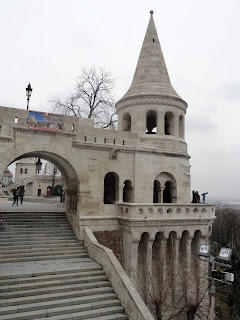4/5
I may have mentioned this before, but the stupidity of it
bears repeating—before we left on the trip from Purkersdorf, we weeded out some
of our excess stuff to leave at Shiri’s rather than carrying it around with us
from city to city. Unfortunately, as we realized on the train from Purkersdorf
to Vienna, the brand new Rick Steves Budapest guide we bought for the trip, and
were planning to read on the bus rides remained in the red carry-on bag in
Shiri’s room! Thankfully, Shiri has a friend from W & L who is studying
abroad in Vienna and agreed to accompany us on our first day there, and help us
to get the lay of the land. She also had a guide someone left behind (from
2000—but better than nothing; really made us appreciate the Rick Steves
guides!), so we met up with her at the Metro station near our house and had a
small breakfast. The weather was pretty cold and quite cloudy, threatening
rain, but we headed to the
center
of town to get the free walking tour of the Pest side of the city. (As you may
have guessed, the city is divided into two sections, Buda and Pest, by the
Danube River which flows through the city.) We arrived at where we thought the
tour was going to begin, but they told us that the 10:30 tour is in fact on the
Buda side, which was over the bridge and up abut 200 steps at the top of the
hill. We made it on time (supposedly) but couldn’t find the tour, and so the
run had been for naught. But we began wandering around using the book as
a guide,
We started at the St. Matyas Church, a beautiful neo-Gothic
church originally built in the 13
th century. We explored the small streets
and alleys of this charming part of the city high on the hill, enjoyed the
somewhat cloud-bedecked views and quaint streets.
 |
| Museum of Applied Arts, right near our U-Bahn stop |
 |
| Matyas Cathedral |
 |
| Plague monument |
 |
| View of Parliament |
 |
| Streets near the castle |
By this time, it had begin to
rain, and at just the right time we passed a place with a sing identifying it as
the Music History Museum. The fees were low, the rain coming down harder, so we
thought, “why not?” I’m so glad we did! It was wonderful—one exhibit with a
collection of Hungarian Folk Instruemnts, another the Bartok Archives, some
modern instruments made by Hungarian craftsmen, and finally a room where you
could actually try out a clavichord, cembalo and piano. It was awesome!
 |
| Awesome music stand for chamber music! |
 |
| Look how much bigger the name of the patron is than the composer! |
 |
| Shiri trying out the hammer dulcimer |
 |
| Liszt lived here |
Once we got out of the museum, we headed up to Castle Hill,
first passing by the Church of St.Mary Magdalene, built in the 13
th
century. It was destroyed a number of times, finally during WWII where all but
the tower and gate were destroyed. They remain today, along with a restored
Gothic window.
We continued down the Lord’s Street (conncting
St. Marys to Castle Hill) and passed
the Residency of the President of Hungary just in time for the modest changing
of the guard ceremony. Since the rain was coming down harder, we decided to
come back to the
Palace (which now
houses the Hungarian National Gallery) at a later date, and headed back to Pest
to the Museum of Terror.
 |
| Changing of the guard--in the rain! |
 |
| I don't envy him his job! |
 |
| President's Office |
 |
| Castle (now and art museum) |
Photos weren’t allowed in the museum (I snuck a few
anyway) but it was a really intense place, commemorating the plight of Hungary
in the 20
th century. They were squeezed between the Nazis on one
side and thr Communists on the other. While there
were probably many leaders who sought to tread the fine line
of pleasing both sides (mostly with below average success), the average Joe was pretty much doomed no matter which
side wound up winning. The exhibits included a Soviet tank, a wall of
remembrance commemorating the victims of the struggles, and other exhibits
recounting the plight of the citizens under both regimes, everyday life in
Hungary during the war, Soviet Propaganda, and the plight and conditions of different
religions during the time. Many of the rooms had video screens with running
interviews with survivors of the Nazis, the Soviet Gulags and Labor Camps and
the Budapest prisons.
In the
basement was the prison itself--the conditions simply unimaginable! I wonder every time I hear the
stories of the survivors, how it would have been possible to survive such
brutality, and live to tell the tale. It was sobering, thought provoking, and
very moving.
 |
| Memorial to victims of Communist and Nazi Terror |
 |
| Soviet and Nazi Uniforms back to back |
 |
| "Everyday Life" |
We had a delicious dinner, sampling many Hungarian and other
international foods in a buffet recommended by our host, wandered home in the
drizzle past Franz Liszt Square, the Opera House, and the Great Synagogue, and, despite the
dismal forecast, hoped for better weather the next day.
 |
| Franz Liszt |
 |
| Opera House at Night |
 |
| Night View of the Great Synagogue: Europe's Largest |











































































No comments:
Post a Comment